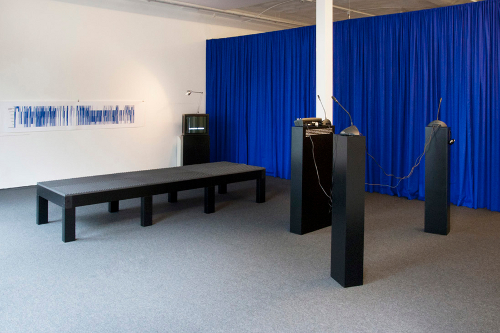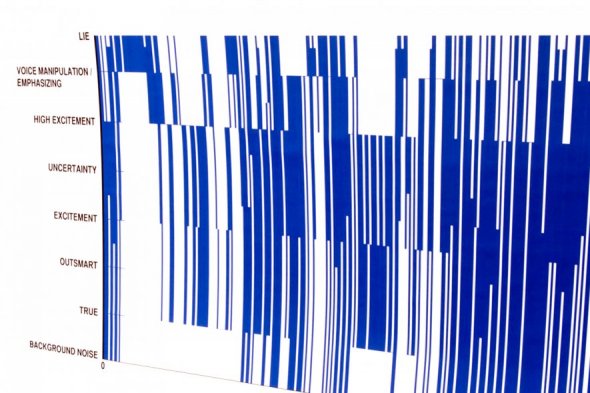Half-Truths
Susan Schuppli discusses the exhibition by Lawrence Abu Hamdan, Aural Contract: The Whole Truth, at Casco in Utrecht
In her 1971 essay, ‘Lying in Politics’, Hannah Arendt contends that in order to act, a space must be created for that action, which by necessity requires that something be removed or destroyed to allow for the new to emerge.
[C]hange would be impossible if we could not mentally remove ourselves from where we are physically located and imagine that things might as well be different from what they actually are. In other words, the ability to lie, the deliberate denial of factual truth, and the capacity to change facts, the ability to act, are interconnected; they owe their existence to the same source, imagination.1
I have always maintained that art’s political potential resides in its aesthetic agency to imagine a different version of events to that of the present. However, Arendt reminds us that the formulation of these new aesthetic ideas are themselves coupled to acts of negation that must annul or modify the existing representations from which they hope to deviate.

In her essay she refers to the sinister side of imagination, specifically the various deceptions revealed by the Pentagon Papers that were promulgated to justify American military intervention into Vietnam. A wilful reorganisation of facts — lying — that she suggests is fundamental to the production of a certain form of the political. Whether these deceits organised the Gulf of Tonkin incident in which falsified radar images depicting North Vietnamese naval aggression were used to pass congressional resolutions allowing the US to wage war against any communist force, or more recently involved the intentional misreading of satellite imagery that lead to UN Security Council Resolution 1441 and the invasion of Iraq. Arendt’s discussion underscores the moral ambiguity of the imaginative register with its capacity for revision as well as speculative projection in the service of new images of reality that are neither unequivocally good nor inherently bad. These new truths, as Michel Foucault has taught us, always operate as a limit condition governing what can be known at any given time and in turn what might be said. Are facts thus only ever half truths conditioned by what we might empirically know about the world at a particular time? Bruno Latour has recently found himself in the strange predicament of wanting to assert the facticity of certain events in the face of a scepticism that would argue against the scientific claims of something like climate change.
While we spent years trying to detect the real prejudices hidden behind the appearance of objective statements, do we now have to reveal the real objective and incontrovertible facts hidden behind the illusion of prejudices? 2
How to reconcile the scientific contingency of facts (its innate uncertainty) with the political efficacy of the lie — its call to action?

Image: Lawrence Abu Hamdan, Aural Contract: The Whole Truth, installation view at Casco in Utrecht
In Lawrence Abu Hamdan’s installation, The Whole Truth, at Casco in Utrecht, technologies aimed at unmasking deliberate deception are themselves unmasked as part of an ongoing audio practice, which examines the legal regimes of the voice.3 The use of forensic probes to analyse acoustic data has increasingly transformed the human voice into a hostile witness capable of testifying against the very subject from whence its vocalisations came. In his radio documentary The Freedom of Speech Itself (2012), Abu Hamdan examined the British Home Office use of forensic speech analysis to assess regional accents and thus the truth claims of asylum seekers to the UK. A mispronounced phoneme sending a refugee claimant back to a country and region they had never lived in before. With his more recent project at Casco he continues to explore technologies aimed at decoding human voice-prints, this time the use of advanced computer algorithms (Layered Voice Analysis or LVA) to ascertain whether statements being made by newly arrived immigrants or emergency services callers, to name but two primary target groups, are true. As an advanced form of lie detection, LVA is being touted as a preemptive anti-terror measure by its Israeli developers that can be used as a pre-screening test for ferreting out individuals attempting to enter the country under false pretences.
The technology is based on a proprietary set of vocal parameters found through research to correlate with key human emotions, and in various combinations to be able to identify deceptive intentions in 'real life' scenarios. These vocal parameters were identified from a bank of audio files taken in different languages and numerous settings, including police interrogations, call centers and controlled experiments.4
Working with Andreas Takenen, a mathematician in the phonetics department at the University of Stockholm, Abu Hamdan was able reverse engineer the LVA 6.50 algorithms to reveal the internal logic of its software (why certain types of sounds and frequencies always seem to register as lies and others conversely always as truths) and by extension expose its built-in prejudices which are based upon probabilistic pattern recognition as are most data tracking software. The calculative dimension of the software, while directed towards minimising the error margin of its analysis is not foolproof and cannot account for the complex lived realities that inflect the voice, especially those for whom political or economic circumstances have resulted in their migration from place to place. Voices are not pure articulations of sonic data that can be quantified and classified but radically remixed vocalisations, which carry the deep traces of cross-cultural encounters over time. While forensics might be conceptualised as producing a biography of the object, its claims are always partial and conditioned by the specific kinds of forums in which such objects can be made to speak.5 During the tenure of the exhibition Abu Hamdan also ran a series of workshops and collaborated with a designer to create a lexicon of ‘conflicted phonemes’ that document the intricate voice-prints of members of the local Somalian community. The resulting graphics highlight the multiple forces that come to shape each individual’s uniquely textured voice. These were presented to the Chairwoman of the Advisory Committee on Migration Affairs, Adriana van Dooijeweert at a press conference at Casco on 14 December 2012.

Image: Lawrence Abu Hamdan, Aural Contract: The Whole Truth, installation view at Casco in Utrecht
If LVA signals the next generation of border management technology, then Abu Hamdan’s audio documentary forces a rethinking of the role that forensics, as an investigative technology directed towards uncovering the ‘truths’ inscribed in (acoustic) matter, increasingly plays in contemporary legal-juridical cultures. In so far as the voice and its speech acts can be recorded and analysed, its presumed immateriality must be reconfigured as forwarding a new conception of materiality derived out of calculation and measurement.6 Art’s political potential is, in this instance, an indictment of a techno-scientific imagination aimed at covering over, rather than revealing the complex nature of speech understood as a materially encoded object in which debates between truth and deception, fact versus fiction, all become contretemps over the future of the new or unknown — the migrant or asylum seeker who arrives ‘unannounced’ at the borders of the nation state.
The efficacy of the lie that Arendt suggests permits a certain kind of political event is thus returned, in Abu Hamdan’s installation, as a critical provocation to the juridical imperative of the ‘whole truth’ and the idea that one can be impelled into speaking ‘nothing but the truth’ — an ideological reversal in which words actually speak louder than actions. This demand for absolute truth signals the initiation of the witness into the American legal system as an agent of credible testimony and is also the operative modality of the technico-legal interrogation of LVA systems. Arendt argues ‘Defactualization and problem solving were welcomed [in US foreign policies] because disregard of reality was inherent in the policies and goals themselves.’7 Statements are rarely entirely true or false but a gradient mixture of half-truths and it is on this distinction that we must act politically and not on any virtuous idea of a reality unencumbered by contradiction and paradox. Authentic speech, Lawrence Abu Hamdan reminds us, cannot be located by way of opposition to inauthentic or deceptive speech. Likewise listening must also be converted from a passive mode of inattention to an active mode of political resistance.
Info
Aural Contract: The Whole Truth by Lawrence Abu Hamdan ran from October 16 – December 16 2012 at Casco, Utrecht.
Footnotes
1 Hannah Arendt, ‘Lying in Politics: Reflections on the Pentagon Papers’, The New York Review of Books, 1971, p.2.
2 Bruno Latour, ‘Why Has Critique Run out of Steam: From Matters of Fact to Matters of Concern’, Critical Inquiry 30. Winter 2004, pp.226-227.
5See the Forensic Architecture website for further elaborations of this idea at http://www.forensic-architecture.org/project/
6The re-conceptualisation of information as a new form of matter is implicit throughout my discussion although not developed herein. This view regards information as possessing many of the autopoietic attributes, such as self-modification and measurement that have traditionally been assigned to the category of organic and physical systems. Within physics and the biological sciences information is now being thought as subject to the same kinds of affordances that shape organic matter. Information, like organic matter, too is capable of ‘self-forming’ and ‘engaging in self-measurement’ thus conferring onto information the status of a quasi-material reality. See Patricia Ticineto Clough, Greg Goldberg, Rachel Schiff, Aaron Weeks and Craig Willse, ‘Notes Towards a Theory of Affect-Itself’, Ephemera: Theory & Politics in Organization 7-1. Immaterial and Affective Labour: Explored (2007). p.61. See also George Caffentzis, ‘Why Machines Cannot Create Value; or, Marx’s Theory of Machines’ in J. Davis, T. Hirschl and M. Stacks (Eds.), Cutting Edge: Technology, Information, Capitalism, and Social Revolution,, London: Verso, 1997.
7 Hannah Arendt, ‘Lying in Politics: Reflections on the Pentagon Papers’, op. cit., p.22.
Mute Books Orders
For Mute Books distribution contact Anagram Books
contact@anagrambooks.com
For online purchases visit anagrambooks.com







